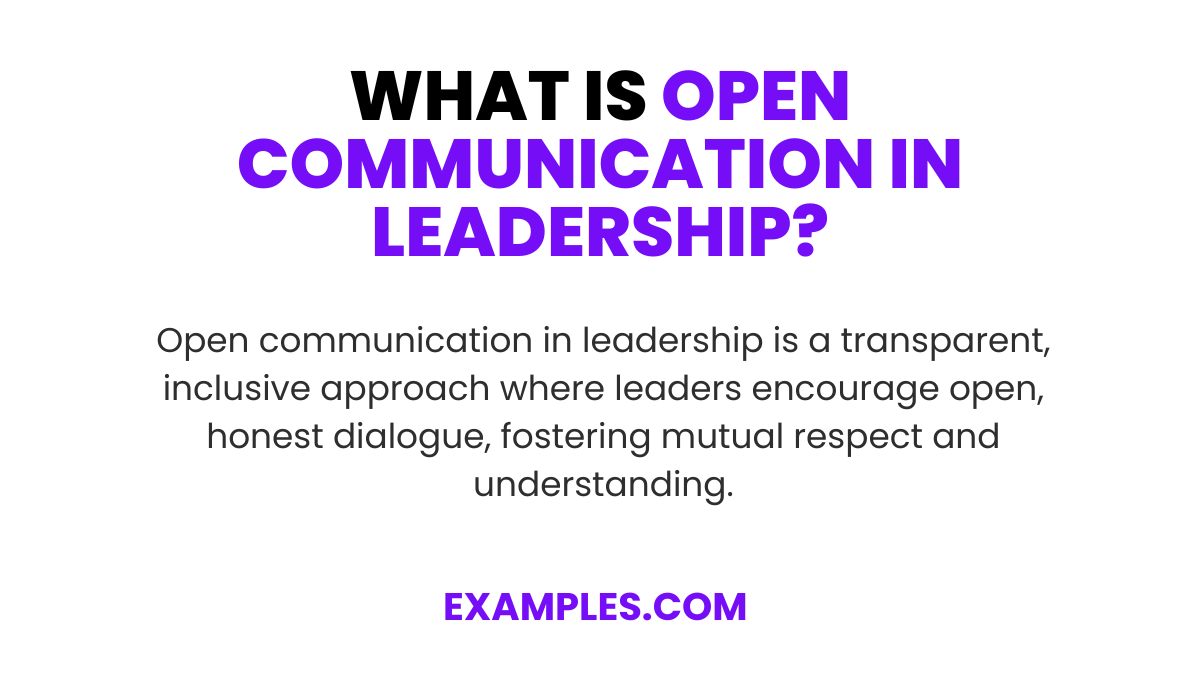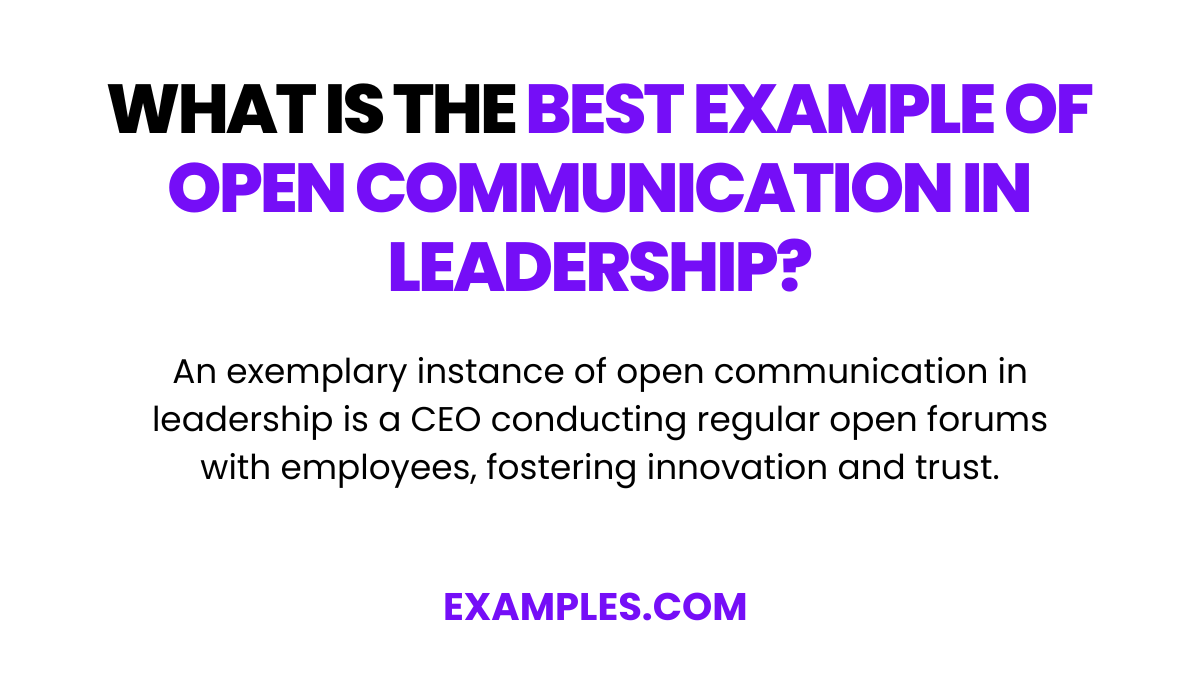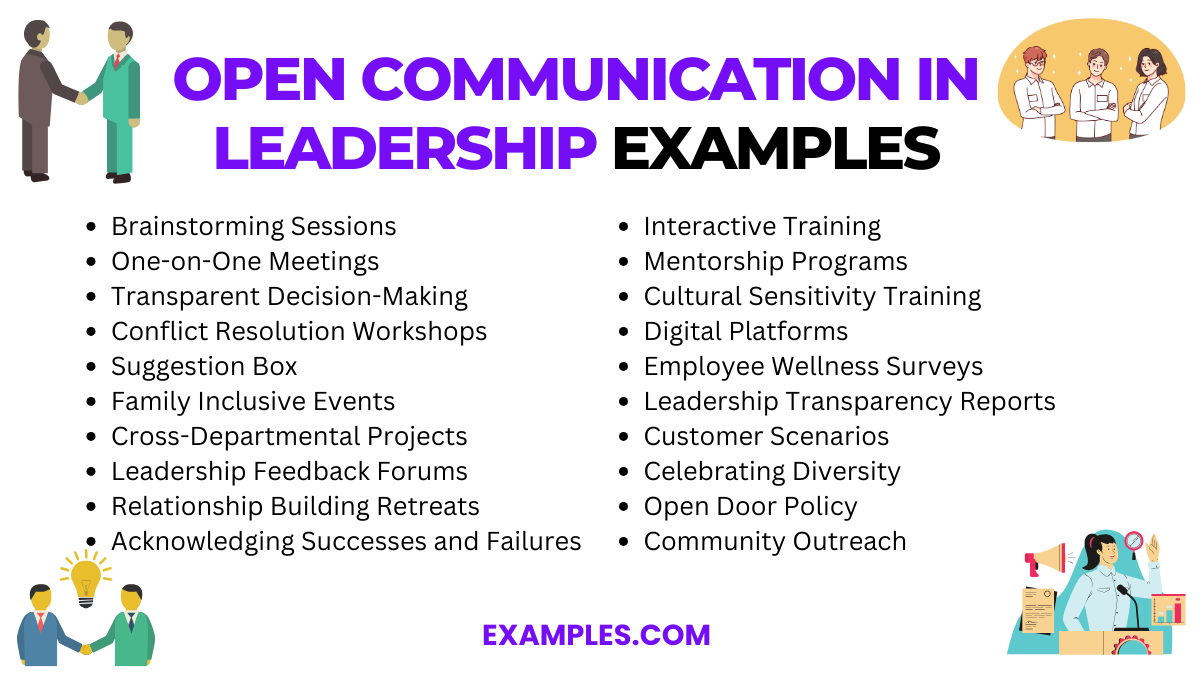19+ Open Communication in Leadership Examples
Dive into the essential guide on Open Communication in Leadership, where transparent dialogues create thriving environments. Discover comprehensive Communication Examples that showcase successful strategies and practices leaders use to foster an inclusive and dynamic workplace. Learn how open communication drives innovation, builds trust, and enhances problem-solving within teams.
Download Tips for Open Communication in Leadership
What is Open Communication in Leadership? – Meaning

Open Communication in leadership is a transparent and inclusive approach where leaders encourage free and honest exchange of ideas, opinions, and information. It involves actively listening, providing feedback, and creating a safe space for dialogue. This fosters mutual respect and understanding, thereby enhancing team cohesion and decision-making efficiency.
What is the Best Example of Open Communication in Leadership?

A prime example of Open Communication Benefits in leadership is a CEO who regularly conducts open forums with employees. These sessions allow staff from all levels to voice ideas, concerns, and feedback directly to top management. The CEO listens actively, responds thoughtfully, and takes actionable steps to address issues. This practice not only boosts morale but also leads to innovative solutions and a strong, trust-filled organizational culture.
20 Open Communication in Leadership Examples

Delving into open communication in leadership, this guide provides 20 distinct examples, each with its unique approach and resolution. These scenarios highlight how effective dialogue can foster trust, encourage innovation, and build a cohesive team environment. Through these examples, leaders can glean insights into promoting a culture of openness and transparency within their organizations.
- Team Brainstorming Sessions: Regular sessions promote Open Communication in the Workplace, encouraging team members to share diverse ideas and collaborate on solutions.
- Weekly One-on-One Meetings: These personalized interactions emphasize the Importance of Open Communication, allowing leaders and employees to build trust and understanding.
- Transparent Decision-Making Process: Leaders sharing rationales and outcomes exemplify Honest Communication, demystifying decisions and aligning team objectives.
- Conflict Resolution Workshops: In Open Communication in Healthcare, these workshops equip staff with the skills to address and resolve conflicts empathetically and efficiently.
- Employee Suggestion Box: Encouraging anonymous feedback, this tool is a practical approach to How to Promote Open Communication, ensuring all voices are heard.
- Family Inclusive Company Events: Events that include families foster an atmosphere of Open Communication in Family, blending personal and professional lives for a supportive community.
- Cross-Departmental Projects: Initiatives that involve multiple departments highlight Why is Open Communication Important in Workplace, breaking down silos and fostering a culture of collaboration.
- Leadership Feedback Forums: These forums are instrumental in How to Create Culture of Open Communication at Workplace, allowing employees to provide constructive feedback to leaders.
- Relationship Building Retreats: Focused on enhancing Open Communication in Relationship, these retreats strengthen interpersonal dynamics among team members.
- Public Acknowledgment of Successes and Failures: Acknowledging outcomes openly in the workplace underscores the Importance of Open Communication in Relationships, promoting a learning culture.
- Interactive Training Sessions: For those in healthcare, Open Communication in Healthcare is vital, and interactive sessions ensure skills are continually honed.
- Mentorship Programs: Such programs foster Open Mind Communication, with seasoned employees sharing insights and guidance in a supportive setting.
- Cultural Sensitivity Training: Emphasizing the Importance of Open Communication, these sessions ensure respect and inclusivity in team interactions.
- Digital Communication Platforms: These tools facilitate Open Communication in the Workplace, especially for teams spread across different locations.
- Employee Wellness Surveys: Featuring open-ended questions, these surveys represent a form of Open Communication Quotes, allowing for honest feedback on the work environment.
- Leadership Transparency Reports: These reports are a testament to Honest Communication, providing clarity and direction for the entire team.
- Role-Playing Customer Scenarios: Engaging in such exercises helps understand diverse perspectives, essential in How to Create Culture of Open Communication at Workplace.
- Celebrating Diversity Events: These events encourage Open Mind Communication, fostering discussions and appreciation of different cultural backgrounds.
- Flexible Open Door Policy: This policy supports Open Communication in Relationship, ensuring leaders are approachable for discussions anytime.
- Community Outreach Programs: Participation in these programs encourages employees to discuss and reflect on company values, embodying How to Promote Open Communication.
Open Communication in Leadership for Workplace
Open communication in leadership within the workplace is pivotal for cultivating a collaborative and transparent environment. Emphasizing Open Communication with Colleagues and Open Communication with Manager, this approach facilitates mutual respect and enhances team productivity. These five unique examples showcase practical ways leaders can implement open communication strategies, fostering a more engaged and efficient workplace.
- Regular Team Huddles: Explanation: These daily or weekly brief meetings keep everyone aligned and informed.
How to Communicate: “Let’s gather for a quick update on our progress and address any immediate concerns.” - Manager’s Open Office Hours: Explanation: Scheduled times where employees can freely discuss ideas or issues with their manager.
How to Communicate: “Feel free to drop by during my open hours for any discussions or help you need.” - Peer Review Sessions: Explanation: Encouraging Open Communication with Colleagues through constructive feedback exchanges among peers.
How to Communicate: “Let’s review each other’s work and provide honest, constructive feedback.” - Leadership Listening Tours: Explanation: Leaders visit different departments to listen to staff concerns and suggestions.
How to Communicate: “I’m here to listen to your experiences and understand how we can improve our work environment.” - Joint Problem-Solving Meetings: Explanation: Collaborative sessions with management and staff to tackle challenges, promoting Open Communication with Manager.
How to Communicate: “Let’s brainstorm together and find the best solution for this challenge.”
How Can Open Communication in Leadership Be Leveraged to Drive Innovation and Problem-Solving Within an Organization?
Open communication in leadership paves the way for a more innovative and problem-solving culture within organizations. It encourages a free flow of ideas, reduces misunderstandings, and builds a foundation for creative and efficient solutions.
- Foster Ideation Sessions: Regularly scheduled sessions that encourage brainstorming and free-thinking among team members can ignite a spark of innovation.
- Establish Feedback Mechanisms: Create systems for feedback that are easy and anonymous, encouraging employees to share insights without fear, much like Open Communication with Child in educational settings.
- Develop a Culture of Trust: Trust is critical. Leaders should act transparently and encourage the same from their team, ensuring a safe space for all ideas.
- Encourage Risk-Taking: By fostering an environment where calculated risks are welcomed, employees feel more comfortable sharing innovative solutions.
- Promote Diversity and Inclusion: Diverse teams bring diverse ideas. Encouraging a variety of perspectives can lead to more innovative problem-solving, much like the broadened perspectives in Open Communication with Parents.
What Challenges May Arise When Implementing Open Communication in Leadership Roles, and How Can They Be Overcome?
While the benefits of open communication in leadership are significant, several challenges might impede its implementation.
- Maintaining Consistency: Consistently maintaining open lines of communication can be challenging. Regular check-ins and updates can help in keeping the flow steady and dependable.
- Ensuring Effective Listening: Sometimes, the issue isn’t speaking up but being heard. Training in active listening can help leaders truly understand and act on team feedback, akin to how medical professionals practice Open Communication with Patients.
- Aligning Individual and Organizational Goals: Misalignment between what employees want and organizational goals can create conflict. Regularly revisiting and realigning these goals can mitigate such issues.
- Dealing with Discomfort: Not everyone is comfortable with openness. Gradually fostering an environment where open communication is normalized can ease this transition.
- Navigating Hierarchical Barriers: Hierarchical structures can sometimes hinder open communication. Flattening communication channels where possible and encouraging direct dialogue can help, similar to the approach in Open Communication with Students, where educators aim to reduce barriers and encourage direct dialogue.
What is the Importance of Open Communication in Leadership?
Open communication in leadership is vital for effective team performance. It promotes transparency, trust, and engagement, ensuring that everyone is aligned with organizational goals and Effective Communication. Following the Rules of Communication, leaders who actively listen and provide feedback create a culture of collaboration. This leads to better problem-solving, innovation, and conflict resolution, ultimately driving success while fostering a positive work environment.
What Are the Key Benefits of Promoting Open Communication in Leadership Roles?
Promoting open communication enhances team trust, boosts morale, and fosters innovative thinking, akin to Open Communication with Stakeholders.
How Can Leaders Cultivate a Culture of Open Communication in Their Teams?
Leaders can encourage feedback, hold regular meetings, and lead by example to foster a culture likened to Open Communication vs Closed Communication.
Why Is It Important to Have an Open Communication Between the Leader and Followers?
Open communication ensures alignment, builds trust, and facilitates quick problem-solving, reflecting the dynamics in Open Communication vs Direct Communication.
In conclusion, open communication in leadership is a powerful catalyst for team success. By exemplifying transparency, active listening, and collaboration, leaders can inspire trust and engagement. Its effects include improved morale, innovation, and conflict resolution. Signs of effective leadership communication are evident in engaged and motivated teams. To enhance open communication, leaders should embrace feedback, foster a culture of trust, and lead by example.



